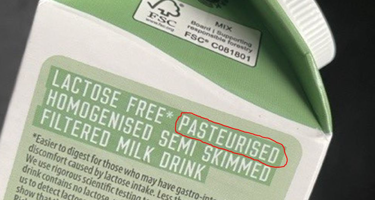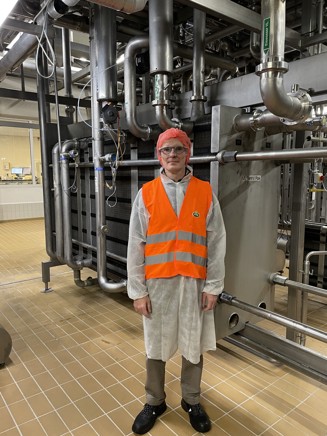
You’re sitting at your breakfast table taking a rare break from scrolling on your phone. You are looking for something to entertain you. So you grab the first thing you see on the table; the milk carton. You start reading the label on pack and the first word you see is ‘pasteurised’. Hmmm, you’re wondering; What is this weird word and what does it have to do with my milk? You can’t resist the urge to grab your phone again (hey-ho), you open Google and start typing: What does pasteurisation mean?
And here we are. You’ve come to the right place. We have asked two of our experts, Søren Lillevang (Dairy Engineer) and Stéphane Renoncourt (Engineering and Technology Manager) in Arla Foods to explain:
- What is pasteurisation and why is it important?
- How does pasteurisation work?
- Does pasteurisation change the nutritional value and taste of milk?
- What does the pasteurisation process look like at the dairy?
- How the heat from the pasteurisation process is reused

What is pasteurisation and why is it important?
Pasteurisation is a process that involves heating food and drink products to kill harmful bacteria and pathogens.
In other words, pasteurisation ensures that products like milk, yoghurt and juice are safe to drink. And on top of that, it also prolongs the products’ shelf-life.
Pasteurisation was invented by the French scientist Louis Pasteur in the 19th century to preserve and prevent spoilage caused by bacteria. The process is named after him in recognition of his pioneering work in microbiology and food safety.
It is a crucial method to prevent the spread of foodborne diseases caused by bacteria such as Tuberculosis, Salmonella, E. coli, and Listeria. It has been credited with saving countless of lives, especially in countries where access to clean and safe food is limited.
How does pasteurisation work?
Pasteurisation happens by heating the milk to no less than 72 degrees for at least 15 seconds. Once the milk has been heated, it is rapidly cooled back down to around 4-5 degrees.
Søren explains in the video below:
The heating of the milk to 72 degrees kills all harmful bacteria and the rapid cooling of the milk makes sure that after the milk leaves the pasteuriser it is at a temperature at which new harmful bacteria cannot grow.
This is what is called high-temperature short-time pasteurisation (HTST), which is the normal practice for fresh milk. It is also called pre-pasteurisation.
Sometimes we pasteurise at higher temperatures. For example, for yoghurt production the milk is pasteurised at 85-90 degrees for 5-6 minutes.
Besides killing harmful bacteria and extending shelf-life, high temperatures can also create certain functionalities in the product. When you reach 85-90 degrees the texture of the milk will become thicker, which is what we want for yoghurts. That is just the first step in creating fermented milk products.
Read more about why yoghurt is thicker than milk in this article.
Does pasteurisation change the nutritional value and taste of milk?
The temperature of pre-pasteurisation (HTST) used for fresh milk and yoghurt is high enough to kill harmful bacteria, but low enough to avoid any noticeable damage to the product’s taste and nutritional value.
Pre-pasteurisation will remove some of the aromatic notes from the raw milk and slightly decrease the vitamin C level in the milk, but it is a fair compro-mise to ensure food safety if you ask us. Nutrients like calcium, protein, vitamin B2, vitamin B12, potassium, phosphorus and iodine are preserved in the pasteurisation process.
Also read: Is milk good for you?
What does the pasteurisation process look like at the dairy?
No matter which type of pasteurisation, the method is always followed by strict quality control procedures at Arla dairies to ensure the milk is safe for consumption.
It all comes down to top-notch technology and machinery, really. At every dairy site you will find ‘pasteurisers’. They are some of the most important mechanical-colleagues we have in Arla.
In the picture below you see Stéphane next to our pasteuriser at Upahl Dairy in Germany.

A ‘pasteuriser’ is the machine that ensures that the milk is heat treated and held for a defined and regulated period to kill all harmful bacteria. In Arla, we strictly follow regulations that all milk should be pasteurised at minimum 72 degrees for at least 15 seconds.
Pasteurisers are carefully designed to ensure the treatment is correct and secure. For example, our pasteurisers have several back-up sensors build into the system that will register and alert if the necessary temperatures are not met.
When the milk arrives at the dairy from our farmer owners, one of the first things it meets is the pasteuriser.
After separating the cream from the milk, it is transferred to the pasteuriser where it will flow between plates. This is where the heat treatment happens and the flow is designed to take exactly 15 seconds before the milk is rapidly cooled back down to 4-5 degrees. The full process is automated and requires no manual interventions.
How the heat from the pasteurisation process is reused
It goes without saying that the pasteurisation process requires heat and that requires quite a bit of energy.
The pasteurisers we use are therefore designed to reuse the heat from the process. How? The heat generated from the pasteurised milk can be used to pre-heat incoming milk.
In Arla Foods, we have a standardised requirement that minimum 90 per cent of the heat used in our pasteurisers should be regenerated, meaning that the process only “uses” 10 per cent of the amount of energy required to bring it up to the pasteurisation temperature.
Stephane explains how it works in the video below:
Overall, reusing the heat generated during pasteurization helps to reduce energy costs, decrease greenhouse gas emissions, and improve the efficiency and sustainability of our dairy operations.
About Søren and Stéphane

Søren Kristian Lillevang is a dairy engineer in Arla Foods, he has been working with everything dairy since he graduated in 1988. Today, he specialises in developing the right dairy technologies for the future and collaborates with universities in Hong Kong, Copenhagen, Stuttgart and Wisconsin.
Stéphane Renoncourt has been working in the dairy industry for 25 years. In his job as Engineering and Technology Manager at Arla, he oversees the design of technology and machinery at our dairy sites to ensure they meet the standards of quality, food safety and sustainability.

